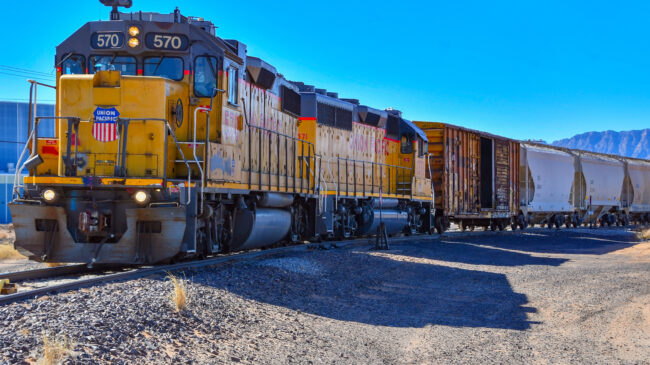Freight rail has been in the news lately over a labor impasse that threatened to shut down the U.S. national rail network earlier this month. Congress ultimately voted to impose a contract that will result in the average rail employee earning $160,000 in annual compensation by 2024. This dustup between rail management and labor will likely not be the last, especially as railroads seek to deploy new productivity-enhancing technologies necessary to compete in an increasingly high-tech transportation marketplace.
Unions are likely to resist labor-saving technologies out of perceived self-interest, but the 20th-century experience with over-regulation in the railroad industry suggests Congress and the Biden administration should be wary of calls to impose regulatory impediments to industry evolution in the 21st century.
My new Reason Foundation policy brief examines the history of economic regulation of the U.S. railroad industry, discusses emerging regulatory threats, and recommends reforms policymakers can enact to ensure freight rail remains on a strong competitive footing going forward.
Railroads were first subjected to national economic regulation under the Interstate Commerce Act of 1887, which created the Interstate Commerce Commission (ICC) to oversee the industry. In the decades that followed, Congress and the ICC produced a growing list of mandates and proscriptions into virtually every rail business decision. Customers and rail carriers could not negotiate customized service contracts under rigid common carrier rules, entry and exit were heavily restricted, and prices were divorced from economic reality, frequently being kept artificially high by regulators to protect weaker competitors (of which there were a great many).
By the middle of the 20th century, new developments such as ubiquitous auto ownership, the Interstate Highway System, rapidly growing trucking companies, and the introduction of jet airliners undercut demand for passenger and freight rail services. Between 1945 and 1955, passenger and freight revenue fell by 71.1% and 12.5%, respectively, while rail’s market share of intercity freight traffic declined from 68.7% to 49.4%.
With fewer financial resources available to support their networks, the railroads began struggling to maintain their existing infrastructure. Congress and the White House grew increasingly concerned that rigid regulation was stifling the industry and preventing it from adapting to new economic conditions but did little beyond issuing official reports that merely acknowledged the worsening problem.
This finally changed in the 1970s when the situation became so dire that inaction was no longer an option. Penn Central, the major rail carrier in the Northeast U.S., filed for bankruptcy in June 1970. This would remain the largest corporate bankruptcy in U.S. history until it was eclipsed by the 2001 Enron collapse. With the Northeast on the verge of losing all meaningful rail service, Congress passed legislation establishing Amtrak in October 1970 to provide passenger rail service too unprofitable for private carriers to continue subsidizing with dwindling freight revenue. This was followed by legislation in 1974 and 1976 that created Conrail, which took over freight rail operations previously undertaken by Penn Central and six other bankrupt railroads in the 17-state Northeast/Midwest service region.
The prospect of perpetual government ownership and management of decrepit rail assets—so dilapidated that regulators began tracking “standing derailments,” incidents where the track bed crumbled away and caused stationary railcars to tip over—proved to be politically unappealing. In this environment, substantive regulatory reform began to be discussed in the halls of power.
Freight rail deregulation began with the 4R Act of 1976. Most significantly, the law legalized contract rates, allowing customers and railroads to negotiate tailored service agreements for the first time since 1903. The ICC even created an advisory office to encourage railroads to take advantage of this new regulatory freedom. In 1979, President Jimmy Carter appointed economist Darius Gaskins to chair the ICC. Gaskins quickly went to work identifying and eliminating the ICC’s bureaucratic inefficiencies, which included demoting career agency employees opposed to reform.
While this was taking place internally at the Interstate Commerce Commission, an emerging consensus among Congress, the Carter administration, industry, consumer advocates, and academia that spanned the ideological spectrum was developing a plan to replace command-and-control rail regulations with market processes. This culminated with the Staggers Rail Act of 1980, which eliminated most economic regulation of the railroads.
The results of the Staggers Act have proved that supporters of economic deregulation were right. The gains enjoyed by carriers and their customers in the decades that followed are large and unambiguous. Inflation-adjusted average freight rates have declined by 44% while freight volume grew by 57%. Even though the law only concerned economic deregulation, the Staggers Act enabled large safety gains, with a 76% decline in train accident rates and an 85% decline in employee injuries and occupational illnesses.
Despite the clear success of partial rail deregulation, some politicians and special interests seek to reverse these reforms and prevent freight railroads from adapting to new competitive market pressures. A coalition of large industrial shippers led by the chemical industry is seeking new regulations that would limit railroads’ return on investment and, thus, capacity to invest in system improvements. Tellingly, these shippers have strongly opposed the ICC’s successor agency, the Surface Transportation Board, adopting robust benefit/cost analysis for major new regulations similar to what has been required of all federal departmental agencies since the Clinton administration.
With rail’s truck competition anticipated to increasingly automate in the coming decades and with labor accounting for nearly half of truck operating costs, rail must also adopt new productivity-enhancing automation technologies to remain viable through the 21st century. Unfortunately, even small movements in this direction—such as by harnessing existing mandated automation and communications technologies to enable single-person crews on some trains, long the default in Western Europe—have been strongly resisted by rail unions. The unions currently have the support of the Federal Railroad Administration (FRA), the rail industry’s safety regulator, which has proposed a rigid crew-size regulation despite conceding it does not possess “any meaningful data” to support the conclusion that two-person train crews are safer than one-person crews.
Organized labor has also opposed automated track inspection that FRA’s own data finds is more accurate than traditional visual inspections. Adopting automated inspection technologies would not only improve safety for the trains operating over the rails, but it would also keep track inspectors out of harm’s way and reduce rail equipment accidents in the field. While FRA was an early supporter of these improved track inspection technologies, it has recently and inexplicably reversed course at the request of rail unions.
Between its recent proposal on crew-size mandates and its reversal on automated track inspection, there is growing evidence that the Federal Railroad Administration has been captured by and subordinated its statutory safety mission to rail labor unions. The good news is Congress can protect the gains realized from the Staggers Act and help usher in 21st-century freight rail.
Congress should mandate that new major rules promulgated by the Surface Transportation Board be supported by robust benefit/cost analysis and limit the agency’s discretionary powers. Congress should also explicitly prohibit the Federal Railroad Administration from regulating train crew size and establish a permanent automated track inspection program not subject to the whims of political appointees.
For more on this topic, see my full Reason Foundation policy brief, “Freight Rail Deregulation: Past Experience and Future Reforms.”

